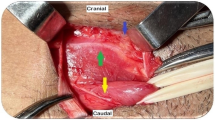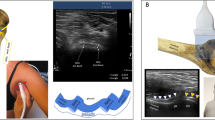Abstract
Purpose
Clinical diagnosis of posterosuperior rotator cuff tears remains uncertain due to a lack of evidence-based consensus. This review aimed to compare the diagnostic accuracy of commonly used clinical tests for posterosuperior rotator cuff tears.
Methods
The authors conducted an electronic literature search using Medline, Embase and the Cochrane library/Central, to identify original clinical studies reporting diagnostic accuracy of clinical tests to diagnose the presence of posterosuperior rotator cuff tears involving the infraspinatus, supraspinatus and/or teres minor.
Results
The electronic literature search returned 1981 records, of which 14 articles were eligible. Among 17 tests included in the systematic review, 6 tests were eligible for meta-analysis: drop arm sign, Jobe test, external rotation lag sign, Hawkins–Kennedy test, Neer test and painful arc abduction test. According to QUADAS-2 criteria, risk of bias was low in 1 study, moderate in 2 and high in 4. The highest pooled sensitivity was 0.77 (CI 0.67–0.85), for the Jobe test, while the lowest pooled sensitivity was 0.38 (CI 0.01–0.98), for the drop arm sign.
Conclusions
The Jobe test had the best pooled sensitivity, while the drop arm sign had the best pooled specificity. As no single clinical test is sufficiently reliable to diagnose posterosuperior rotator cuff tears, clinicians should consider various combinations of patient characteristics and clinical tests, as well as imaging modalities, to confirm diagnosis and select the appropriate treatment option. More reliable clinical diagnosis of posterosuperior rotator cuff tears could reduce the reliance on magnetic resonance imaging or arthrography and their associated costs and waiting times.
Level of evidence
Level II







Similar content being viewed by others
References
Aguila-Ledesma IR, Cordova-Fonseca JL, Medina-Pontaza O, Nunez-Gomez DA, Calvache-Garcia C et al (2017) Diagnostic value of a predictive model for complete ruptures of the rotator cuff associated to subacromial impingement. Acta Ortop Mex 31(3):108–112
Akl E, Altman D, Aluko P, Askie L, Beaton D et al. (2019) Cochrane handbook for systematic reviews of interventions. Wiley, The Atrium, Southern Gate, Chichester, West Sussex, UK. https://doi.org/10.1002/9781119536604
Bakhsh W, Nicandri G (2018) Anatomy and physical examination of the shoulder. Sports Med Arthrosc Rev 26(3):e10–e22
Beaudreuil J, Nizard R, Thomas T, Peyre M, Liotard JP et al (2009) Contribution of clinical tests to the diagnosis of rotator cuff disease: a systematic literature review. Joint Bone Spine 76(1):15–19
Beckmann NM (2020) Editorial commentary: is magnetic resonance imaging of the shoulder ever appropriate in evaluating patients with calcific tendinopathy of the rotator cuff? Arthroscopy 36(4):991–992
Besnard M, Freychet B, Clechet J, Hannink G, Saffarini M et al. (2020) Partial and complete repairs of massive rotator cuff tears maintain similar long-term improvements in clinical scores. Knee Surg Sports Traumatol Arthrosc. https://doi.org/10.1007/s00167-020-05907-8
Brockmeyer M, Schmitt C, Haupert A, Kohn D, Lorbach O (2017) Limited diagnostic accuracy of magnetic resonance imaging and clinical tests for detecting partial-thickness tears of the rotator cuff. Arch Orthop Trauma Surg 137(12):1719–1724
Cadogan A, McNair P, Laslett M, Hing W, Taylor S (2013) Diagnostic accuracy of clinical examination features for identifying large rotator cuff tears in primary health care. J Man Manip Ther 21(3):148–159
Castoldi F, Blonna D, Hertel R (2009) External rotation lag sign revisited: accuracy for diagnosis of full thickness supraspinatus tear. J Shoulder Elbow Surg 18(4):529–534
Cho CH, Bae KC, Kim DH (2020) Patients who have undergone rotator cuff repair experience around 75% functional recovery at 6 months after surgery. Knee Surg Sports Traumatol Arthrosc. https://doi.org/10.1007/s00167-020-06019-z
Codman E (1984) The shoulder: rupture of the supraspinatus tendon and other lesions in or about the subdeltoid bursa. Krieger Publishing, Malabar
Collin P, Colmar M, Thomazeau H, Mansat P, Boileau P et al (2018) Clinical and MRI outcomes 10 years after repair of massive posterosuperior rotator cuff tears. J Bone Joint Surg Am 100(21):1854–1863
Collin P, Treseder T, Denard PJ, Neyton L, Walch G et al (2015) What is the best clinical test for assessment of the teres minor in massive rotator cuff tears? Clin Orthop Relat Res 473(9):2959–2966
Costouros JG, Espinosa N, Schmid MR, Gerber C (2007) Teres minor integrity predicts outcome of latissimus dorsi tendon transfer for irreparable rotator cuff tears. J Shoulder Elbow Surg 16(6):727–734
Deeks JJ, Altman DG (2004) Diagnostic tests 4: likelihood ratios. BMJ 329(7458):168–169
Galasso O, Mantovani M, Muraccini M, Berardi A, De Benedetto M et al (2019) The latissimus dorsi tendon functions as an external rotator after arthroscopic-assisted transfer for massive irreparable posterosuperior rotator cuff tears. Knee Surg Sports Traumatol Arthrosc. https://doi.org/10.1007/s00167-019-05819-2
Gerber C, Rahm SA, Catanzaro S, Farshad M, Moor BK (2013) Latissimus dorsi tendon transfer for treatment of irreparable posterosuperior rotator cuff tears: long-term results at a minimum follow-up of ten years. J Bone Joint Surg Am 95(21):1920–1926
Gismervik SO, Drogset JO, Granviken F, Ro M, Leivseth G (2017) Physical examination tests of the shoulder: a systematic review and meta-analysis of diagnostic test performance. BMC Musculoskelet Disord 18(1):41
Hawkins R, Kennedy J (1980) Impingement syndrome in athletes. Am J Sports Med 8(3):151–158
Hegedus EJ, Goode A, Campbell S, Morin A, Tamaddoni M et al (2008) Physical examination tests of the shoulder: a systematic review with meta-analysis of individual tests. Br J Sports Med 42(2):80–92
Hegedus EJ, Goode AP, Cook CE, Michener L, Myer CA et al (2012) Which physical examination tests provide clinicians with the most value when examining the shoulder? Update of a systematic review with meta-analysis of individual tests. Br J Sports Med 46(14):964–978
Hermans J, Luime JJ, Meuffels DE, Reijman M, Simel DL et al (2013) Does this patient with shoulder pain have rotator cuff disease? The Rational Clinical Examination systematic review. JAMA 310(8):837–847
Hertel R, Ballmer F, Lambert S, Gerber C (1996) Lag signs in the diagnosis of rotator cuff rupture. J Shoulder Elbow Surg 5(4):307–313
Higgins JP, Altman DG, Gotzsche PC, Juni P, Moher D et al (2011) The Cochrane Collaboration's tool for assessing risk of bias in randomised trials. BMJ 343:d5928
Hughes PC, Taylor NF, Green RA (2008) Most clinical tests cannot accurately diagnose rotator cuff pathology: a systematic review. Aust J Physiother 54(3):159–170
Jain NB, Fan R, Higgins LD, Kuhn JE, Ayers GD (2018) Does my patient with shoulder pain have a rotator cuff tear? A predictive model from the ROW cohort. Orthop J Sports Med 6(7):2325967118784897
Jain NB, Wilcox RB 3rd, Katz JN, Higgins LD (2013) Clinical examination of the rotator cuff. PMR 5(1):45–56
Jobe FW, Moynes DR (1982) Delineation of diagnostic criteria and a rehabilitation program for rotator cuff injuries. Am J Sports Med 10(6):336–339
Kim HA, Kim SH, Seo YI (2007) Ultrasonographic findings of the shoulder in patients with rheumatoid arthritis and comparison with physical examination. J Korean Med Sci 22(4):660–666
Kooistra B, Gurnani N, Weening A, van den Bekerom M, van Deurzen D (2019) Low level of evidence for all treatment modalities for irreparable posterosuperior rotator cuff tears. Knee Surg Sports Traumatol Arthrosc 27(12):4038–4048
Lasbleiz S, Quintero N, Ea K, Petrover D, Aout M et al (2014) Diagnostic value of clinical tests for degenerative rotator cuff disease in medical practice. Ann Phys Rehabil Med 57(4):228–243
Leeflang MM, Deeks JJ, Rutjes AW, Reitsma JB, Bossuyt PM (2012) Bivariate meta-analysis of predictive values of diagnostic tests can be an alternative to bivariate meta-analysis of sensitivity and specificity. J Clin Epidemiol 65(10):1088–1097
Litaker D, Pioro M, El Bilbeisi H, Brems J (2000) Returning to the bedside: using the history and physical examination to identify rotator cuff tears. J Am Geriatr Soc 48(12):1633–1637
Liu F, Dong J, Kang Q, Zhou D, Xiong F (2020) Subacromial balloon spacer implantation for patients with massive irreparable rotator cuff tears achieves satisfactory clinical outcomes in the short and middle of follow-up period: a meta-analysis. Knee Surg Sports Traumatol Arthrosc. https://doi.org/10.1007/s00167-019-05834-3.
Liu F, Dong J, Shen WJ, Kang Q, Zhou D et al (2020) Detecting rotator cuff tears: a network meta-analysis of 144 diagnostic studies. Orthop J Sports Med 8(2):2325967119900356
Longo UG, Berton A, Ahrens PM, Maffulli N, Denaro V (2011) Clinical tests for the diagnosis of rotator cuff disease. Sports Med Arthrosc Rev 19(3):266–278
McFarland EG, Garzon-Muvdi J, Jia X, Desai P, Petersen SA (2010) Clinical and diagnostic tests for shoulder disorders: a critical review. Br J Sports Med 44(5):328–332
McFarland EG, Selhi HS, Keyurapan E (2006) Clinical evaluation of impingement: what to do and what works. Instr Course Lect 55:3–16
McInnes MDF, Moher D, Thombs BD, McGrath TA, Bossuyt PM et al (2018) Preferred reporting items for a systematic review and meta-analysis of diagnostic test accuracy studies: the PRISMA-DTA statement. JAMA 319(4):388–396
Millett PJ, Warth RJ (2014) Posterosuperior rotator cuff tears: classification, pattern recognition, and treatment. J Am Acad Orthop Surg 22(8):521–534
Nadarajah V, Stevens KN, Henry L, Jauregui JJ, Smuda MP et al (2020) Patients undergoing shoulder surgery have high preoperative expectations. Knee Surg Sports Traumatol Arthrosc. https://doi.org/10.1007/s00167-019-05824-5
Pennock AT, Pennington WW, Torry MR, Decker MJ, Vaishnav SB et al (2011) The influence of arm and shoulder position on the bear-hug, belly-press, and lift-off tests: an electromyographic study. Am J Sports Med 39(11):2338–2346
Reitsma JB, Glas AS, Rutjes AW, Scholten RJ, Bossuyt PM et al (2005) Bivariate analysis of sensitivity and specificity produces informative summary measures in diagnostic reviews. J Clin Epidemiol 58(10):982–990
Roquelaure Y, Ha C, Rouillon C, Fouquet N, Leclerc A et al (2009) Risk factors for upper-extremity musculoskeletal disorders in the working population. Arthritis Rheum 61(10):1425–1434
Sgroi M, Loitsch T, Reichel H, Kappe T (2018) Diagnostic value of clinical tests for supraspinatus tendon tears. Arthroscopy 34(8):2326–2333
Sgroi M, Loitsch T, Reichel H, Kappe T (2019) Diagnostic value of clinical tests for infraspinatus tendon tears. Arthroscopy 35(5):1339–1347
Simovitch RW, Helmy N, Zumstein MA, Gerber C (2007) Impact of fatty infiltration of the teres minor muscle on the outcome of reverse total shoulder arthroplasty. J Bone Joint Surg Am 89(5):934–939
Somerville LE, Willits K, Johnson AM, Litchfield R, LeBel ME et al (2014) Clinical assessment of physical examination maneuvers for rotator cuff lesions. Am J Sports Med 42(8):1911–1919
Sucuoglu H, Asan A (2020) Relationship between calcific tendinopathy and rotator cuff tear on shoulder magnetic resonance imaging: case-controlled comparison. Pol J Radiol 85:e8–e13
van Kampen DA, van den Berg T, van der Woude HJ, Castelein RM, Scholtes VA et al (2014) The diagnostic value of the combination of patient characteristics, history, and clinical shoulder tests for the diagnosis of rotator cuff tear. J Orthop Surg Res 9:70
Villafane JH, Valdes K, Anselmi F, Pirali C, Negrini S (2015) The diagnostic accuracy of five tests for diagnosing partial-thickness tears of the supraspinatus tendon: a cohort study. J Hand Ther 28(3):247–251 (quiz 252)
Walch G, Nové-Josserand L, Liotard J, Noel E, Tavernier T et al. (2005) The teres minor muscle: the forgotten muscle of the rotator cuff. Shoulder: A Multidisciplinary Approach, Montpellier, France: Sauramps Medical, pp 237–244 (in French)
Author information
Authors and Affiliations
Contributions
AL participated in conception, design and interpretation of data, and manuscript writing. TM participated in conception, design, analysis and interpretation of data, and manuscript editing. PJD participated in conception, search replication and manuscript revision. MI participated in conception, design, grey literature review and manuscript revision. MS participated in conception, design, data extraction, analysis and interpretation of data, and manuscript drafting. PC participated in conception, search replication and manuscript revision.
Corresponding author
Ethics declarations
Conflict of interest
AL is a paid consultant for Wright, Arthrex and Medacta and received royalties from Wright. PC is a paid consultant for Arthrex and Wright and receives royalties from Wright. PJD is a paid consultant for Arthrex. TM, MS and MI declare that they have no competing interests.
Ethical approval
The study protocol including the search strategy was registered on PROSPERO (CRD42019137256).
Additional information
Publisher's Note
Springer Nature remains neutral with regard to jurisdictional claims in published maps and institutional affiliations.
Electronic supplementary material
Below is the link to the electronic supplementary material.
Rights and permissions
About this article
Cite this article
Lädermann, A., Meynard, T., Denard, P.J. et al. Reliable diagnosis of posterosuperior rotator cuff tears requires a combination of clinical tests. Knee Surg Sports Traumatol Arthrosc 29, 2118–2133 (2021). https://doi.org/10.1007/s00167-020-06136-9
Received:
Accepted:
Published:
Issue Date:
DOI: https://doi.org/10.1007/s00167-020-06136-9




